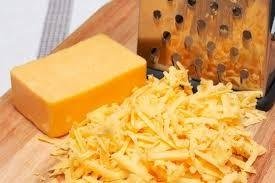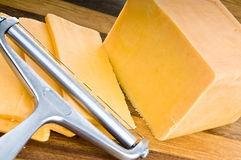Stars of Cheeses 🧀 The Cheddar cheese (9)
The Cheddar cheese

Is a relatively hard, off-white (or orange if spices such as annatto are added), sometimes sharp-tasting, natural cheese. Originating in the English village of Cheddar in Somerset, cheeses of this style are produced beyond this region and in several countries around the world.
Cheddar is the most popular type of cheese in the UK, accounting for 51% of the country's £1.9 billion annual cheese market. It is the second-most popular cheese in the US (behind mozzarella), with an average annual consumption of 4.5 kg per capita. The US produced approximately 1,400,000 tonnes in 2014, and the UK 262,000 tonnes in 2008.

The term "Cheddar cheese" is widely used, but has no protected designation of origin within the European Union. However, in 2007, a Protected Designation of Origin, "West Country Farmhouse Cheddar", was created and only Cheddar produced from local milk within Somerset, Dorset, Devon and Cornwall and manufactured using traditional methods may use the name.
Outside Europe, the style and quality of cheeses labelled as cheddar may vary greatly; furthermore, cheeses that are more similar in taste and appearance to Red Leicester are sometimes popularly marketed as "Red Cheddar".

History
The cheese originates from the village of Cheddar in Somerset, south west England. Cheddar Gorge on the edge of the village contains a number of caves, which provided the ideal humidity and steady temperature for maturing the cheese. Cheddar cheese traditionally had to be made within 48 km of Wells Cathedral.
Cheddar has been produced since at least the 12th century. A pipe roll of King Henry II from 1170 records the purchase of 4,640 kg at a farthing per pound. Charles I also bought cheese from the village. Romans may have brought the recipe to Britain from the Cantal region of France.
Central to the modernisation and standardisation of Cheddar cheese was the 19th-century Somerset dairyman Joseph Harding. For his technical innovations, promotion of dairy hygiene, and volunteer dissemination of modern cheese-making techniques, he has been dubbed "the father of Cheddar cheese".

Harding introduced new equipment to the process of cheese-making, including his "revolving breaker" for curd cutting, saving much manual effort. The "Joseph Harding method" was the first modern system for Cheddar production based upon scientific principles. Harding stated that Cheddar cheese is "not made in the field, nor in the byre, nor even in the cow, it is made in the dairy". His wife and he were behind the introduction of the cheese into Scotland and North America. His sons, Henry and William Harding, were responsible for introducing Cheddar cheese production to Australia and facilitating the establishment of the cheese industry in New Zealand, respectively.
During the Second World War, and for nearly a decade after, most milk in Britain was used for the making of one single kind of cheese nicknamed "government Cheddar" as part of war economies and rationing. This almost resulted in wiping out all other cheese production in the country. Before the First World War, more than 3,500 cheese producers were in Britain; fewer than 100 remained after the Second World War.

According to a United States Department of Agriculture researcher, Cheddar cheese is the world's most popular variety of cheese, and the most studied type of cheese in scientific publications.
The curds and whey are separated using rennet, an enzyme complex normally produced from the stomachs of newborn calves (in vegetarian or kosher cheeses, bacterial, yeast or mould-derived chymosin is used).
"Cheddaring" refers to an additional step in the production of Cheddar cheese where, after heating, the curd is kneaded with salt, cut into cubes to drain the whey, and then stacked and turned. Strong, extra-mature Cheddar, sometimes called vintage, needs to be matured for up to 15 months. The cheese is kept at a constant temperature, often requiring special facilities. As with other hard cheese varieties produced worldwide, caves provide an ideal environment for maturing cheese; still, today, some Cheddar cheese is matured in the caves at Wookey Hole and Cheddar Gorge. Additionally, some versions of Cheddar cheese are smoked.
This is produced in Holland but I am wrong
I guess when it comes to cheese, I'm a normal American. My top 2 favorites are mozzarella & cheddar.
delicious and yuummyy food 😍😍
Delicious recipe. I invite to visit my blog. Good luck.
Wonderful history i like your post
Gotta love the sharp cheddar every once in a while! Cheese is just the best. Thanks for sharing this beautiful ode to the Ched
great. i want it
wah this delicious cheese made in side food.
Such an amazing food & history. Thanks @indesta120282! You are wonderful.